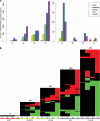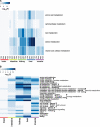Interorgan coordination of the murine adaptive response to fasting
- PMID: 21393243
- PMCID: PMC3091239
- DOI: 10.1074/jbc.M110.216986
Interorgan coordination of the murine adaptive response to fasting
Abstract
Starvation elicits a complex adaptive response in an organism. No information on transcriptional regulation of metabolic adaptations is available. We, therefore, studied the gene expression profiles of brain, small intestine, kidney, liver, and skeletal muscle in mice that were subjected to 0-72 h of fasting. Functional-category enrichment, text mining, and network analyses were employed to scrutinize the overall adaptation, aiming to identify responsive pathways, processes, and networks, and their regulation. The observed transcriptomics response did not follow the accepted "carbohydrate-lipid-protein" succession of expenditure of energy substrates. Instead, these processes were activated simultaneously in different organs during the entire period. The most prominent changes occurred in lipid and steroid metabolism, especially in the liver and kidney. They were accompanied by suppression of the immune response and cell turnover, particularly in the small intestine, and by increased proteolysis in the muscle. The brain was extremely well protected from the sequels of starvation. 60% of the identified overconnected transcription factors were organ-specific, 6% were common for 4 organs, with nuclear receptors as protagonists, accounting for almost 40% of all transcriptional regulators during fasting. The common transcription factors were PPARα, HNF4α, GCRα, AR (androgen receptor), SREBP1 and -2, FOXOs, EGR1, c-JUN, c-MYC, SP1, YY1, and ETS1. Our data strongly suggest that the control of metabolism in four metabolically active organs is exerted by transcription factors that are activated by nutrient signals and serves, at least partly, to prevent irreversible brain damage.
Figures





References
Publication types
MeSH terms
Substances
Associated data
- Actions
LinkOut - more resources
Full Text Sources
Molecular Biology Databases
Research Materials
Miscellaneous

